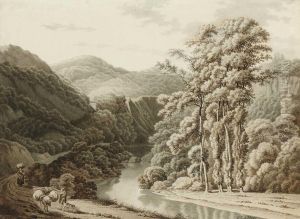Pieter Rudolph Kleyn Paintings
Pieter Rudolph Kleyn, a relatively lesser-known figure in the expansive world of art history, was born in 1749. His contributions, primarily rooted in the 18th century, reflect the artistic transitions of the time, capturing the evolving tastes and ideas that preluded the modern era. Not much is widely known about Kleyn's early life, a common issue when studying artists from this period, especially those who did not reach the pinnacle of fame. However, his works and the limited historical records suggest a deep engagement with the artistic movements of his time.
Kleyn's artistic journey is often characterized by his exploration of landscape painting, a genre that underwent significant transformation during his lifetime. This period saw a shift from the grand, idealized landscapes inspired by classical antiquity to more naturalistic and emotionally resonant scenes. Kleyn, like many of his contemporaries, might have been influenced by these changing tastes, adapting his style to fit the emerging preference for realism and emotional depth in landscape art.
Despite the scarcity of detailed records about his personal life and career, Kleyn's surviving works offer a glimpse into his artistic vision and technique. Through these paintings, one can infer his keen observation of the natural world, a hallmark of the period's evolving landscape genre. His ability to capture the subtle interplay of light and shadow, as well as the meticulous rendering of natural details, suggests a profound connection with his subjects and a mastery of his medium.
The year 1807 marked the end of Kleyn's life and career. While he may not have achieved the fame of his more illustrious peers, his contributions to the landscape genre provide valuable insights into the artistic transitions of the late 18th century. Through his works, Pieter Rudolph Kleyn offers a window into the changing world of his time, reflecting the broader shifts in European art and culture. His legacy, though modest in comparison to the giants of art history, underscores the importance of every artist's voice in the rich tapestry of the past.

